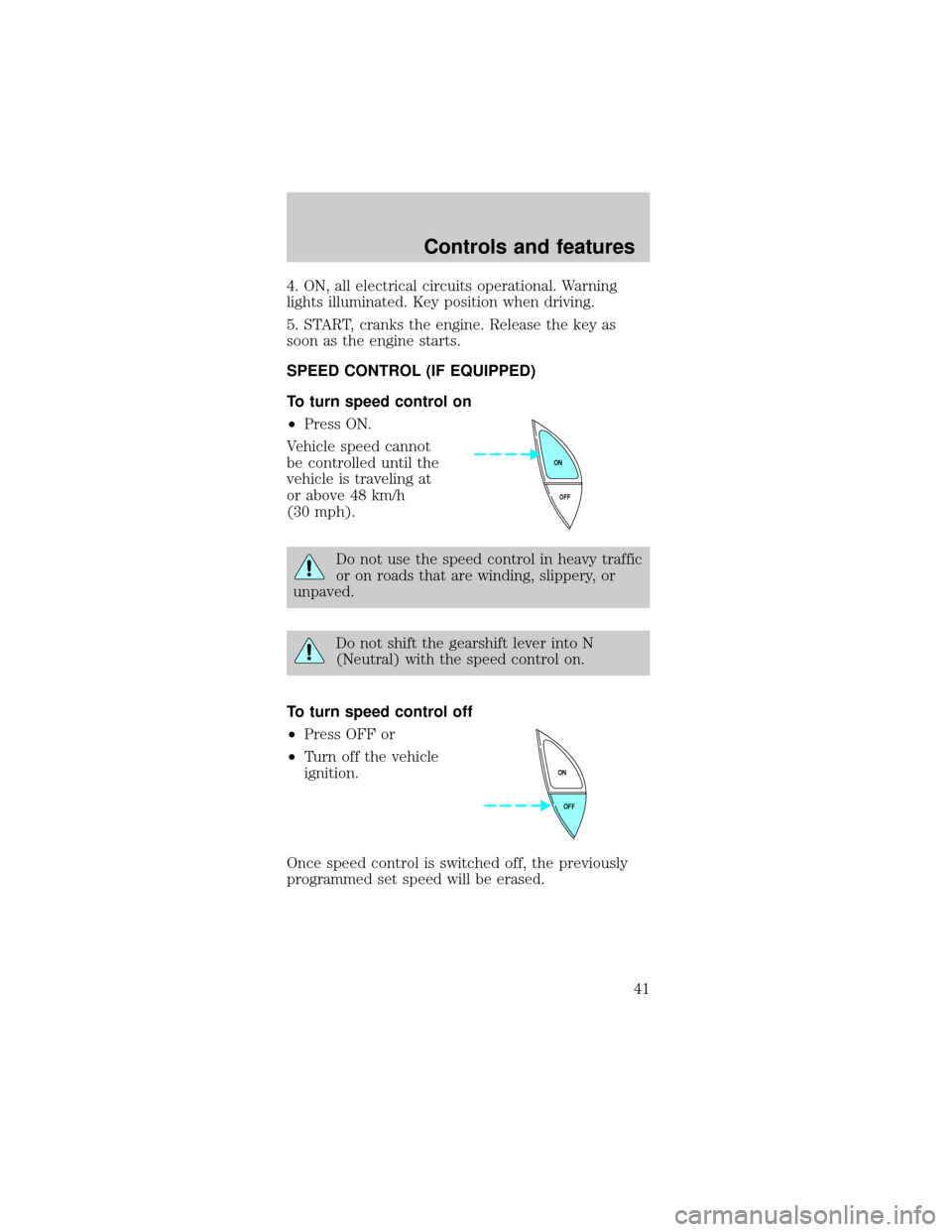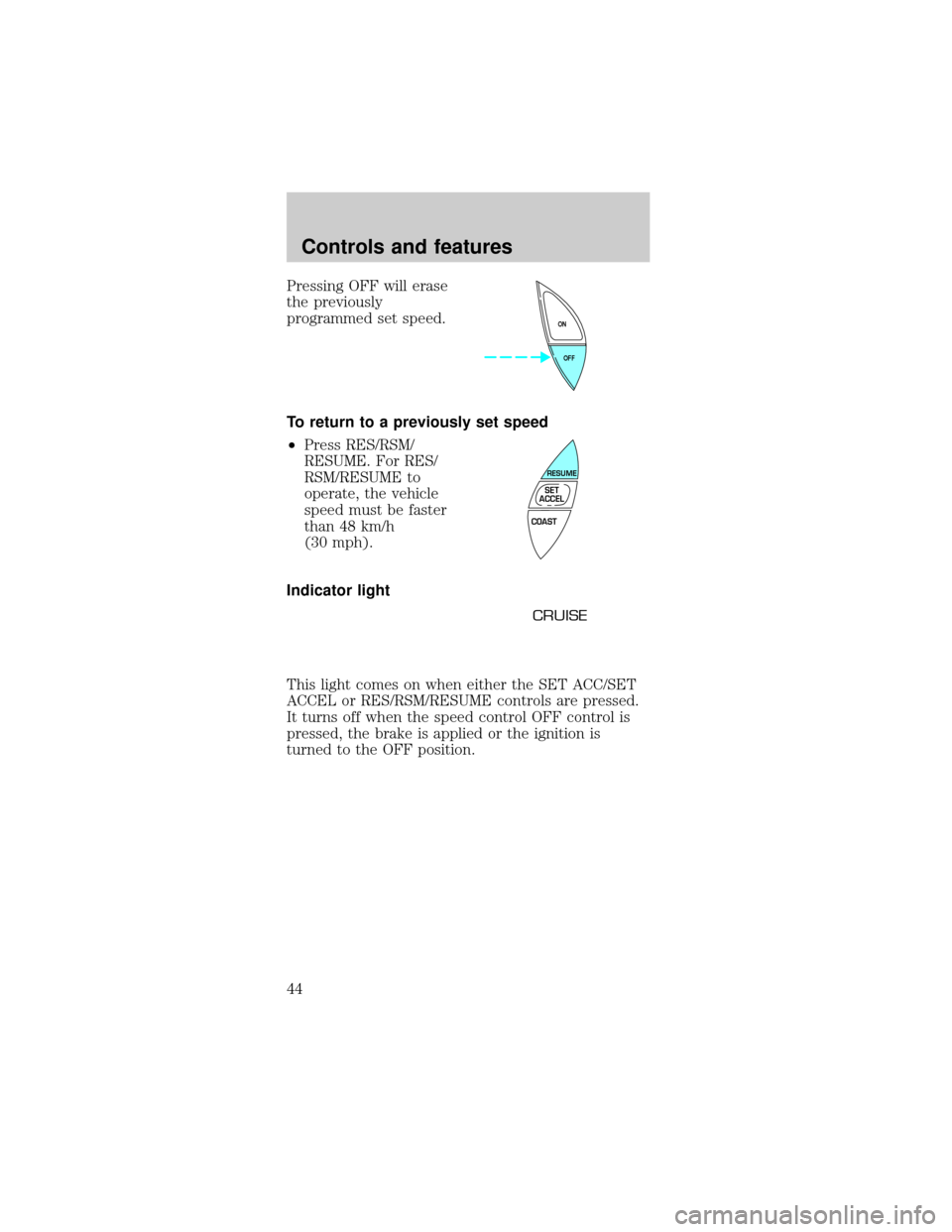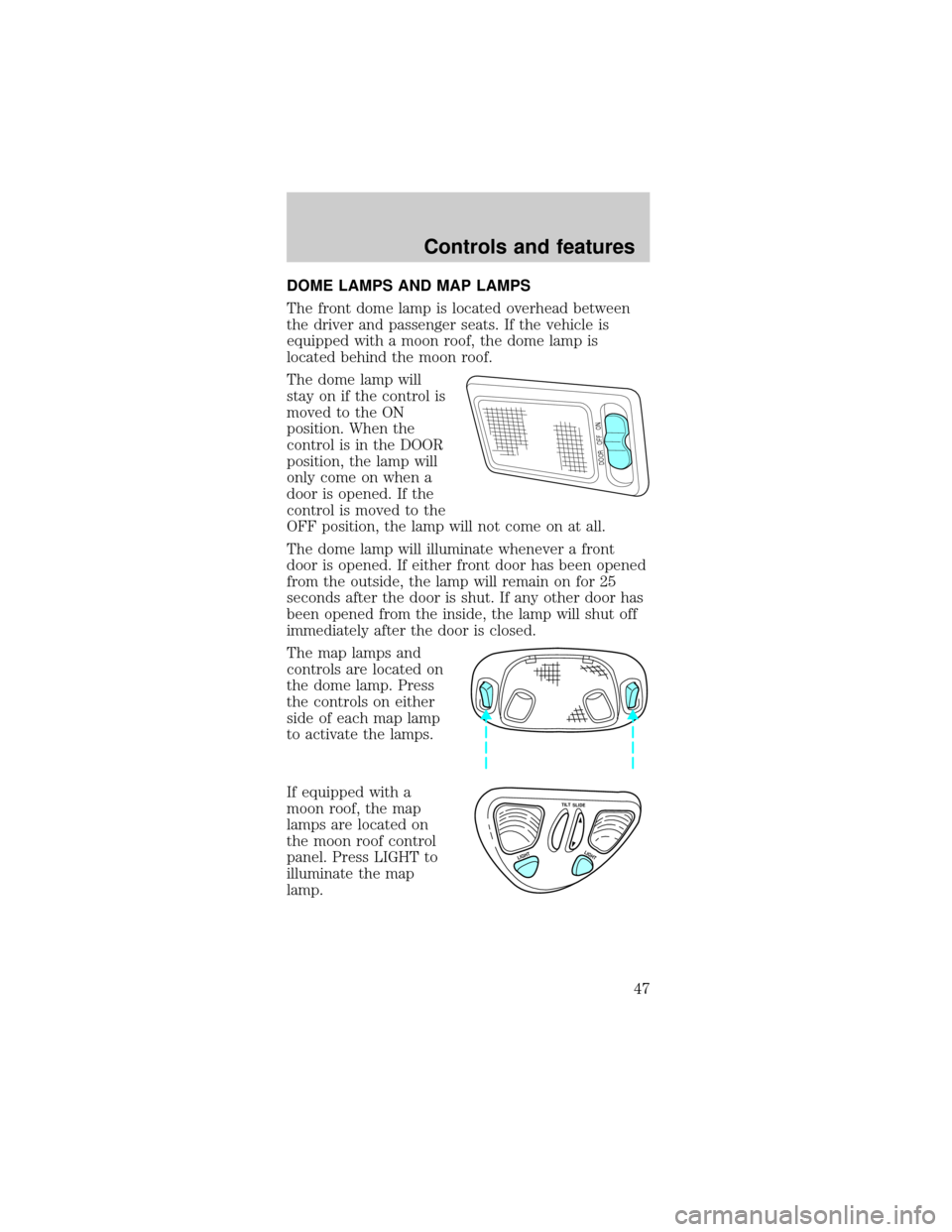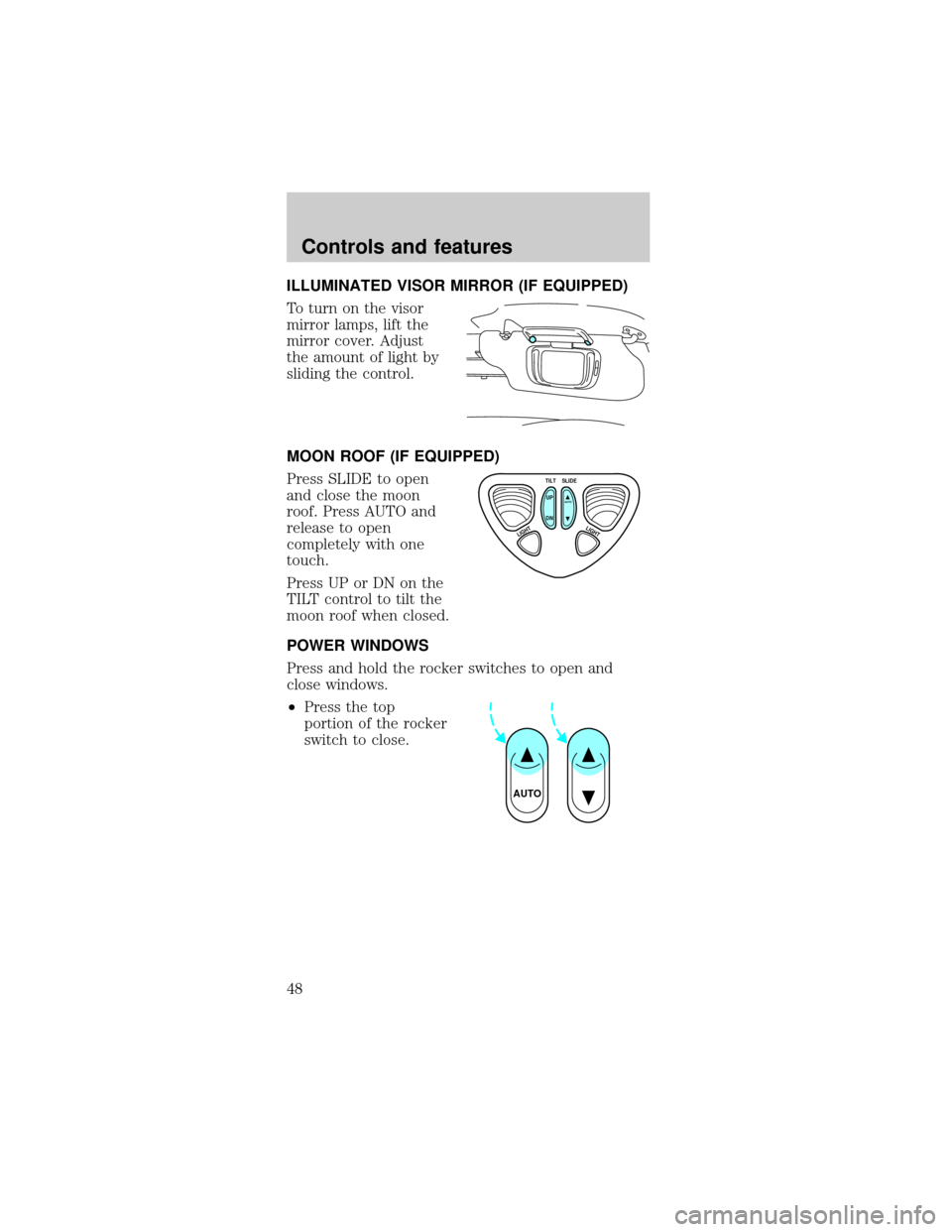light Mercury Sable 1999 s User Guide
[x] Cancel search | Manufacturer: MERCURY, Model Year: 1999, Model line: Sable, Model: Mercury Sable 1999Pages: 216, PDF Size: 1.33 MB
Page 20 of 216

²A/C-Uses outside air to cool the vehicle. It is
quieter than MAX A/C but not as economical.
Airflow will be from the instrument panel
registers.
²VENT-Distributes outside air through the
instrument panel registers. However, the air will
not be cooled below the outside temperature
because the air conditioning does not operate in
this mode.
²OFF-Outside air is shut out and the fan will not
operate. For short periods of time only, use this
mode to prevent undesirable odors from entering
the vehicle.
²
(Panel and floor)-Distributes outside air
through the instrument panel registers and the
floor ducts. Heating and air conditioning
capabilities are provided in this mode. For added
customer comfort, when the temperature control
knob is anywhere in between the full hot and full
cold positions, the air distributed through the
floor ducts will be slightly warmer than the air
sent to the instrument panel registers.
²
(Floor)-Allows for maximum heating by
distributing outside air through the floor ducts.
However, the air will not be cooled below the
outside temperature because the air conditioning
does not operate in this mode.
²
(Floor and defrost)-Distributes outside air
through the windshield defroster ducts and the
floor ducts. Heating and air conditioning
capabilities are provided in this mode. For added
customer comfort, when the temperature control
knob is anywhere in between the full hot and full
cold positions, the air distributed through the
floor ducts will be slightly warmer than the air
sent to the instrument panel registers. If the
temperature is about 10ÉC (50ÉF) or higher, the
air conditioner will automatically dehumidify the
air to prevent fogging.
Controls and features
20
Page 26 of 216

²MAX A/C-Uses recirculated air to cool the vehicle.
The temperature will remain unchanged and air
will be cooled based on the selected temperature.
To exit, press AUTOMATIC or any other override
controls. MAX A/C is noisier than normal A/C but
more economical and will cool the inside of the
vehicle faster. Airflow is from the instrument
panel registers. This mode can also be used to
prevent undesirable odors from entering the
vehicle.
²VENT-Distributes outside air through the
instrument panel registers. However, the air
cannot be cooled below the outside temperature
because the air conditioning does not operate in
this mode.
²
-Distributes outside air through the
instrument panel registers and the floor ducts.
Heating and air conditioning capabilities are
provided in this mode. The air will be heated or
cooled based on the temperature selection. For
added customer comfort, the air distributed
through the floor ducts will be slightly warmer
than the air sent to the instrument panel
registers.
²
-Allows for maximum heating by distributing
outside air through the floor ducts. However, the
air cannot be cooled below the outside
temperature because the air conditioning does not
operate in this mode.
²
-Distributes outside air through the
windshield defroster ducts and the floor ducts.
Heating and air conditioning capabilities are
provided in this mode. The air will be heated or
cooled based on the temperature selection. For
added customer comfort, the air distributed
through the floor ducts will be slightly warmer
than the air sent to the windshield defroster
ducts. If the temperature is about 10ÉC (50ÉF) or
higher, the air conditioner will automatically
dehumidify the air to prevent fogging.
Controls and features
26
Page 34 of 216

²Speaker sound can
be adjusted between
the front and rear
speakers.
Inserting a tape
Push only slightly when
inserting a cassette
tape (with the open
edge to the right). A cassette deck loading
mechanism pulls the tape in the rest of the way.
You can switch from CD to tape play by inserting a
tape into the cassette deck.
Tape/CD select
²To begin tape play
(with a tape loaded
into the audio
system) while in the
radio or CD mode, press the TAPE control. Press
the button during rewind or fast forward to stop
the rewind or fast forward function.
²To begin CD play (if CDs are loaded in the CD
changer), press the CD button. The first track of
the first disc will begin playing. After that CD play
will begin where it stopped last.
Rewind
The rewind control
works in tape and CD
modes.
²In tape mode, radio play will continue until
rewind is stopped (with the TAPE control) or the
beginning of the tape is reached.
BASS
TREB
BAL
FADE
DOLBY B ®TAPECDEJECT
TAPECD
REW
5
Controls and features
34
Page 38 of 216

The CD magazine may be inserted or ejected with
the radio power off.
Troubleshooting the CD changer (if equipped)
The laser beam used in the compact disc
player is harmful to the eyes. Do not
attempt to disassemble the case.
If sound skips:
²You may be traveling on a rough road, playing
badly scratched discs or the disc may be dirty.
Skipping will not scratch the discs or damage the
player.
If your changer does not work, it may be that:
²A disc is already loaded where you want to insert
a disc.
²The disc is inserted with the label surface
downward.
²The disc is dusty or defective.
²The player's internal temperature is above 60ÉC
(140ÉF). Allow the player to cool down before
operating.
²A disc with format and dimensions not within
industry standards is inserted.
Cleaning compact discs
Inspect all discs for contamination before playing. If
necessary, clean discs only with an approved CD
cleaner and wipe from the center out to the edge.
Do not use circular motion.
CD and CD changer care
²Handle discs by their edges only. Never touch the
playing surface.
²Do not expose discs to direct sunlight or heat
sources for extended periods of time.
Controls and features
38
Page 39 of 216

²Do not insert more than one disc into each slot of
the CD changer magazine.
Cleaning cassette player (if equipped)
Clean the tape player head with a cassette cleaning
cartridge after ten to twelve hours of play in order
to maintain the best sound and operation.
Cassette and cassette player care
²Use only cassettes that are 90 minutes long or
less.
²Do not expose tapes to direct sunlight, high
humidity, extreme heat or extreme cold. Allow
tapes that may have been exposed to extreme
temperatures to reach a moderate temperature
before playing.
²Tighten very loose tapes by inserting a finger or
pencil into the hole and turning the hub.
²Remove loose labels before inserting tapes.
²Do not leave tapes in the cassette player for a
long time when not being played.
Radio frequency information
The Federal Communications Commission (FCC)
and the Canadian Radio and Telecommunications
Commission(CRTC) establish the frequencies AM
and FM stations may use for their broadcasts.
Allowable frequencies are:
AM 530, 540±1600, 1610 kHz
FM 87.9, 88.1±107.1, 107.9 MHz
Not all frequencies are used in a given area.
Radio reception factors
Three factors can affect radio reception:
²Distance/strength.The further an FM signal
travels, the weaker it is. The listenable range of
the average FM station is approximately 40 km
(24 miles). This range can be affected by ªsignal
Controls and features
39
Page 40 of 216

modulation.º Signal modulation is a process radio
stations use to increase their strength/volume
relative to other stations.
²Terrain.Hills, mountains and tall buildings
between your vehicle's antenna and the radio
station signal can cause FM reception problems.
Static can be caused on AM stations by power
lines, electric fences, traffic lights and
thunderstorms. Moving away from an interfering
structure (out of its ªshadowº) returns your
reception to normal.
²Station overload.Weak signals are sometimes
captured by stronger signals when you pass a
broadcast tower. A stronger signal may
temporarily overtake a weaker signal and play
while the weak station frequency is displayed.
The audio system automatically switches to single
channel reception if it will improve the reception of
a station normally received in stereo.
Audio system warranties and service
Refer to the ªWarranty Guideº for audio system
warranty information.
If service is necessary, see your dealer or a qualified
technician.
POSITIONS OF THE IGNITION
1. ACCESSORY, allows
the electrical
accessories such as the
radio to operate while
the engine is not
running.
2. LOCK, locks the
steering wheel,
automatic transmission gearshift lever and allows
key removal.
3. OFF, shuts off the engine and all accessories
without locking the steering wheel.
1
23
4
5
Controls and features
40
Page 41 of 216

4. ON, all electrical circuits operational. Warning
lights illuminated. Key position when driving.
5. START, cranks the engine. Release the key as
soon as the engine starts.
SPEED CONTROL (IF EQUIPPED)
To turn speed control on
²Press ON.
Vehicle speed cannot
be controlled until the
vehicle is traveling at
or above 48 km/h
(30 mph).
Do not use the speed control in heavy traffic
or on roads that are winding, slippery, or
unpaved.
Do not shift the gearshift lever into N
(Neutral) with the speed control on.
To turn speed control off
²Press OFF or
²Turn off the vehicle
ignition.
Once speed control is switched off, the previously
programmed set speed will be erased.
OFF ON
OFF ON
Controls and features
41
Page 44 of 216

Pressing OFF will erase
the previously
programmed set speed.
To return to a previously set speed
²Press RES/RSM/
RESUME. For RES/
RSM/RESUME to
operate, the vehicle
speed must be faster
than 48 km/h
(30 mph).
Indicator light
This light comes on when either the SET ACC/SET
ACCEL or RES/RSM/RESUME controls are pressed.
It turns off when the speed control OFF control is
pressed, the brake is applied or the ignition is
turned to the OFF position.
OFF ON
COAST
RESUME
SET
ACCEL
CRUISE
Controls and features
44
Page 47 of 216

DOME LAMPS AND MAP LAMPS
The front dome lamp is located overhead between
the driver and passenger seats. If the vehicle is
equipped with a moon roof, the dome lamp is
located behind the moon roof.
The dome lamp will
stay on if the control is
moved to the ON
position. When the
control is in the DOOR
position, the lamp will
only come on when a
door is opened. If the
control is moved to the
OFF position, the lamp will not come on at all.
The dome lamp will illuminate whenever a front
door is opened. If either front door has been opened
from the outside, the lamp will remain on for 25
seconds after the door is shut. If any other door has
been opened from the inside, the lamp will shut off
immediately after the door is closed.
The map lamps and
controls are located on
the dome lamp. Press
the controls on either
side of each map lamp
to activate the lamps.
If equipped with a
moon roof, the map
lamps are located on
the moon roof control
panel. Press LIGHT to
illuminate the map
lamp.
DOOR OFF ON
TILT
LIGHTLIGHT
SLIDE
Controls and features
47
Page 48 of 216

ILLUMINATED VISOR MIRROR (IF EQUIPPED)
To turn on the visor
mirror lamps, lift the
mirror cover. Adjust
the amount of light by
sliding the control.
MOON ROOF (IF EQUIPPED)
Press SLIDE to open
and close the moon
roof. Press AUTO and
release to open
completely with one
touch.
Press UP or DN on the
TILT control to tilt the
moon roof when closed.
POWER WINDOWS
Press and hold the rocker switches to open and
close windows.
²Press the top
portion of the rocker
switch to close.
TILT
UP
LIGHTLIGHT
AUTO
DNSLIDE
AUTO
Controls and features
48